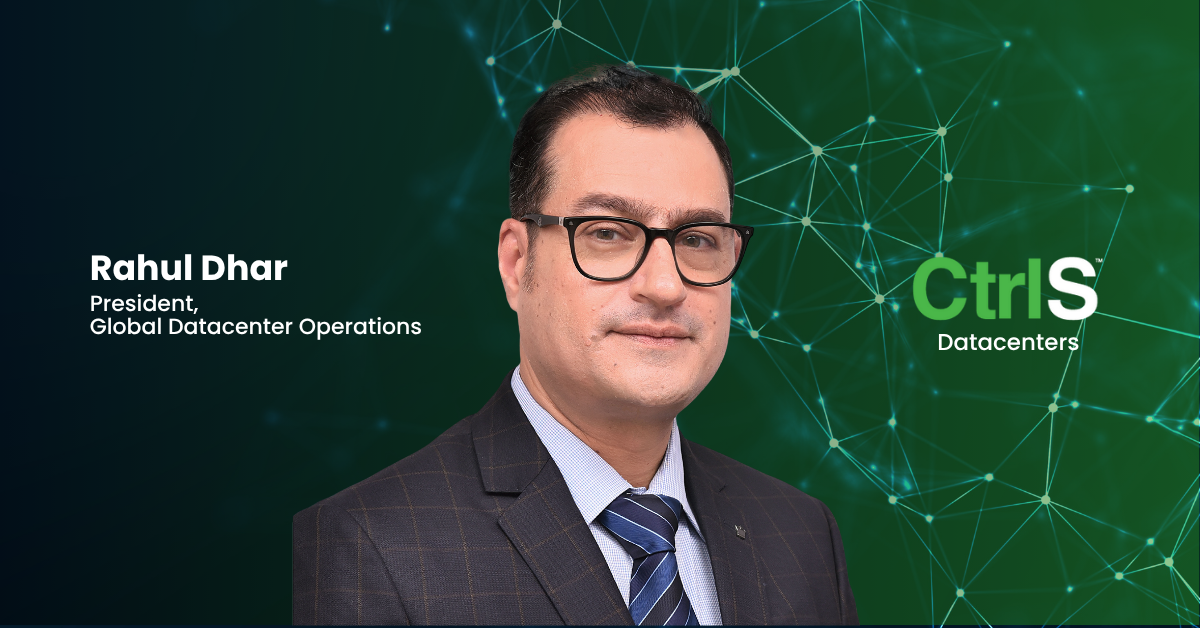CtrlS Datacenters, a key player in South Asia’s data center landscape, has taken yet another step towards actualizing its global expansion plans. It has appointed digital infrastructure industry veteran Rahul Dhar as President of Global Datacenter Operations. At present, CtrlS operates 16 data centers across nine key markets of India. It plans to explore new overseas markets in the Middle East and Southeast Asia, with Thailand being the first international market foray.
With nearly two decades of leadership experience leading critical infrastructure and technology teams, Dhar brings an understanding of managing and scaling mission-critical data center operations. He recently served as Country Director – Datacenters at Microsoft India, overseeing the strategic direction, operational resilience, and capacity planning of Microsoft’s cloud infrastructure in the region. Earlier in his career, Dhar held senior leadership roles at Tata Communications, COLT, and Vodafone, where he led cross-geographic teams, delivered large-scale programs, and drove major process transformations across global operations. His career journey began in Europe and evolved into senior positions in India, showcasing a steady progression from hands-on engineering leadership to executive oversight of data center strategy and operations.
In his new role, Dhar will lead the company’s global operations charter. He will establish a Central Command Center to strengthen visibility and incident response, drive process excellence through standardization and automation, and institutionalize training and competency programs to prepare teams for future scale. He will also be responsible for ensuring operational resilience and reliability, improving uptime and recovery, and coordinating across infrastructure, facilities, and support functions to maintain the highest standards of service quality across CtrlS’ expanding global footprint.
To better understand his leadership style and plans, w.media caught up with Rahul Dhar for this exclusive tête-à-tête:
As a technology business leader, how do you envision the idea of digital transformation?
The idea of digital transformation has been in the talks for a while now. My vision of digital transformation is closely tied to the base infrastructure. It’s Operational Resiliency and Agility.
Transformation is crucial for the internal machinery of the business. This involves:
Data-Driven Decision Making: We must evolve from siloed data to a unified, accessible data architecture where real-time analytics and AI power every significant decision, from strategy to frontline operations.
Intelligent Automation: Leveraging AI and automation to streamline core processes, eliminate manual tasks, and improve quality, allowing our human talent to focus on innovation and complex problem-solving.
Cloud-Native & Distributed Technology: Adopting cloud platforms and a modern architectural approach (like microservices) to ensure our technology is flexible, scalable, secure, and enables teams to innovate and deploy solutions independently and rapidly.
What is the one thing about the global digital infrastructure industry that you find most exciting?
I am getting more and more curious about denser architectures and hardware(s) of the future. How far can we compress the transistors to be accommodated on every square centimeter (or millimeter) of physical chip space? Another aspect that I am highly excited about is how to cool these highly dense microprocessor factories, which are actually the foundation stones of every computation that is invisibly powering the current & future AI revolution. We are all learning how to use liquid cooling to its best. A new era is opening for thermal engineers to contribute to high-power computing and its use cases. This innovation is essential to house the powerful GPUs and specialized AI chips, pushing the limits of physics and engineering.
What attracted you to join CtrlS, and what will be your key focus areas as President – Global Datacenter Operations?
CtrlS is a young and mature Datacenter Services & Managed Services provider that focuses on innovation and customer success. In summary, their popularity stems from offering ultra-reliable (Rated-4) and highly secure digital infrastructure on a massive scale, while also being recognized for their commitment to energy efficiency in the rapidly growing Indian and Asian markets.
My remit is going to be Operational Excellence, Central Command Center setup, and People Development as one of the top three result areas.
Could you shed some light on your leadership style, and the key leadership qualities you value the most?
I value human potential the most. My idea of leadership is to put people first. Over the years, I have been fairly successful to mould a large set of leaders under my umbrella who can take complex decisions and develop their own teams. They are currently well-equipped to drive customer success.
What are some technological innovations and international best practices that you find most valuable, and how do you plan to incorporate them in your plans for CtrlS?
Closely working with Green Energy teams is going to be one of my most valuable contributions, which is a key focus for every large DC provider globally. The extent to which we can incentivize the use of renewable energy is going to shape the profit margins of any DC provider and pave the way for more modern and grid-friendly data centers.
Indian data center companies are dreaming big. What role can they play on the global level?
India is rapidly transforming into one of the world’s most dynamic data center markets, with capacity projected by JLL to rise from about 1,150 MW in 2024 to around 1,825 MW by 2027. This scale enables Indian companies to serve not only domestic demand but also provide a cost-competitive base for global hyperscalers. The combination of reliable infrastructure, access to skilled talent, and geographic advantage positions India to become a hub for South Asia and beyond. Moreover, as sustainability becomes a global benchmark, Indian operators with renewable energy adoption and advanced cooling innovations can differentiate themselves as leaders in green, AI-ready infrastructure. In short, Indian data center organizations have the potential to be both enablers of the domestic digital economy and exporters of world-class infrastructure capabilities.
Can a National Data Center Policy empower homegrown data center companies to become global giants?
The draft National Data Center Policy 2025 has the potential to be a real inflection point for the industry. Its emphasis on fiscal incentives, faster clearances, and renewable energy adoption directly addresses the high capital intensity and operational challenges of data center projects. Measures like long-term tax benefits, GST credits, and performance-linked incentives can significantly improve ROI, while provisions for pre-approved land and reliable clean power can shorten deployment timelines and reduce risks. What will ultimately define the policy’s success is uniform adoption across states and timely execution of these measures. If implemented effectively, it can reshape India’s investment landscape, lower costs, and position the country as a sustainable, globally competitive hub for hyperscale, cloud, and AI infrastructure.”
How has 2025 been for the industry so far, and what do you look forward to the most in 2026?
2025 has been a year of acceleration. The demand for AI and high-performance computing has reshaped design priorities, pushing providers to build higher-density, liquid-cooled facilities and commit to renewable energy on a larger scale. We have also seen a rise in investment into edge data centers, ensuring resilience and lower latency in non-metro markets. For CtrlS, this year has underscored the importance of combining cyber-resilience, sustainability, and operational scale to meet client needs. Looking ahead, 2026 is poised to be the year of consolidation and policy clarity. We expect stronger movement on a national framework for data centers, greater focus on ESG as a core business imperative, and continued investment into AI-ready infrastructure. With these shifts, Indian data centers will not just keep pace with global trends but help shape the next chapter of the digital economy.





